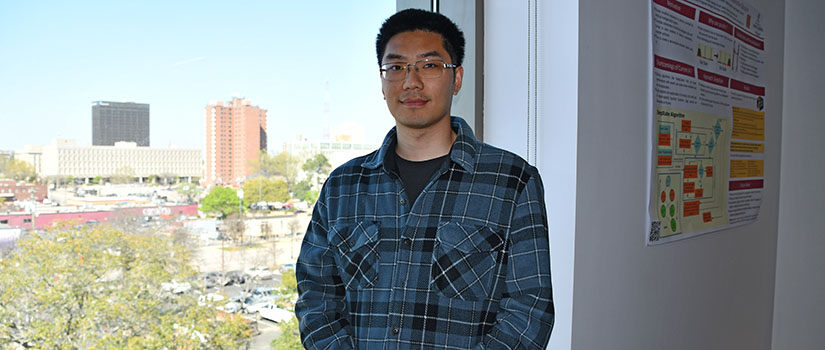Most scientists believe that the universe follows symmetric patterns and principles that remain unchanged under transformation. These symmetries affect conservation laws for properties such as mass and energy and electric charge that evolve over time.
Computer Science and Engineering Assistant Professor Qi Zhang is also affiliated with the Artificial Intelligence Institute of University of South Carolina. Since AI systems have already benefited from exploiting symmetries, Zhang is preparing research to identify and utilize symmetries for cooperative AI tasks.
Zhang recently received the five-year National Science Foundation (NSF) CAREER Award for research that will begin this May. His project seeks to identify and exploit symmetries that are prevalent in cooperative AI tasks. This is when a group of sequential decision makers, also known as autonomous agents, plan and learn to maximize their combined benefit. Zhang’s research will establish a unified framework and develop a set of interdependent methods that formulate, identify and exploit multi-agent symmetries for cooperative AI tasks.
“I realized that problems with multi-agent coordination learning and planning are complicated. But if our algorithms can exploit some structure in subclasses, it might make it work more efficiently. Fortunately, many problems exhibit some symmetric structures,” Zhang says.
Cooperative AI is the core component in any AI system that involves multiple autonomous agents collectively accomplishing a shared goal. Zhang cited his current NSF research into applying adaptive traffic signal controls as an example of cooperative AI tasks. Each intersection is modeled as an agent controlling its traffic signal by adapting to real-time traffic conditions and reducing congestion. Certain symmetries exist when the topology of the road network is regular, such as a four-connected grid or uniform road condition. These multi-agent symmetries can be identified and exploited to improve the efficiency and effectiveness of the current solutions using cooperative AI.
“More people are now realizing the potential of multi-agent planning and learning its many applications. Unfortunately, existing solutions often require either too much data or samples which we don't typically have in most real world applications. So any solution that tries to mitigate these requirements has the potential to have a huge impact,” Zhang says.
Zhang intends to adopt rigorous language to formulate the notion of multi-agent symmetry to reveal its core property, which can be exploited by planning and learning methods. It will also concentrate on exploiting several of the most common types of multi-agent symmetries, such as permutation, Euclidean and other symmetries of mixed types.
Permutation symmetry is the basic understanding that each member of the multi-agent team can be swapped without changing its nature.
“Think of it as a soccer match. There’s the goalkeeper and everyone else. Non-goalkeepers can change their roles without changing the nature of the team. But if you swap the goalkeeper with a non-goalkeeper, that’s a fundamental change of the game and team,” Zhang says. “We have some recent results showing how and to what extent you exploit swapping to design better methodologies for multi-agent planning and learning problems.”
Zhang will also examine the Euclidean symmetry, which refers to a group of symmetries of any figure in a space. This also means that the problem exists in a 3D world.
“For example, if a state changes by rotation, every coordinate changes accordingly by that rotation. But its nature is still the same. You don't change anything except for the coordinate, which is the reference point and orientation,” Zhang says. “If that's the case, then my algorithm should see a single state or instance without too much differentiation before and after rotation.”
In addition to adaptive traffic control signals, other real-world applications include automated circuit and material designs. Zhang is currently collaborating on research to utilize AI and some of the symmetries to design better materials.
“The first thing we want to know is how to better predict materials and properties. After that, we can just manipulate the materials to make them easier to exhibit the desired specific properties,” Zhang says. “For example, as an atom evolves, it becomes a multi-agent system when you consider the whole material structure. The permutation and Euclidean symmetries both exist, especially when placed in a 3D space. There’s also the ability to swap in those materials.”
NSF CAREER Award recipients must also integrate educational initiatives as part of their research. Zhang is excited to help design an interdisciplinary AI master program that would be available to all College of Engineering and Computing students.
“Students can take some core AI courses as either the prerequisite or the required courses. They can select some sub areas that are in their major or interest them with some interdisciplinary aspects of AI,” Zhang says. “I think this project might be a good source of curriculum resources for the so-called AI interfacing monitoring.”
Zhang added that he envisions his research will be an interleaving of the theoretical and fundamental aspect of the problem with real-world applications.
“If we find something that is fundamentally important, we want to see if it’s only a breakthrough in theory or if it can transfer from the lab to a larger, real-world application.”
